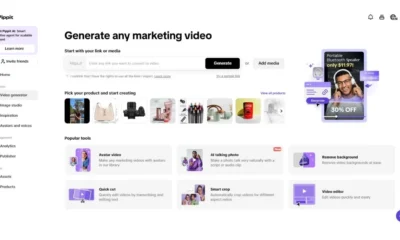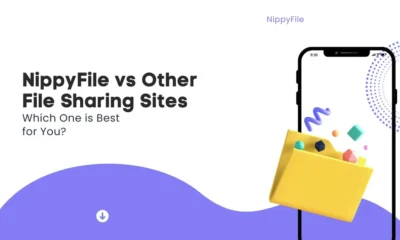AI
How to Build AI-Powered Video Presentations for Sales Pitches
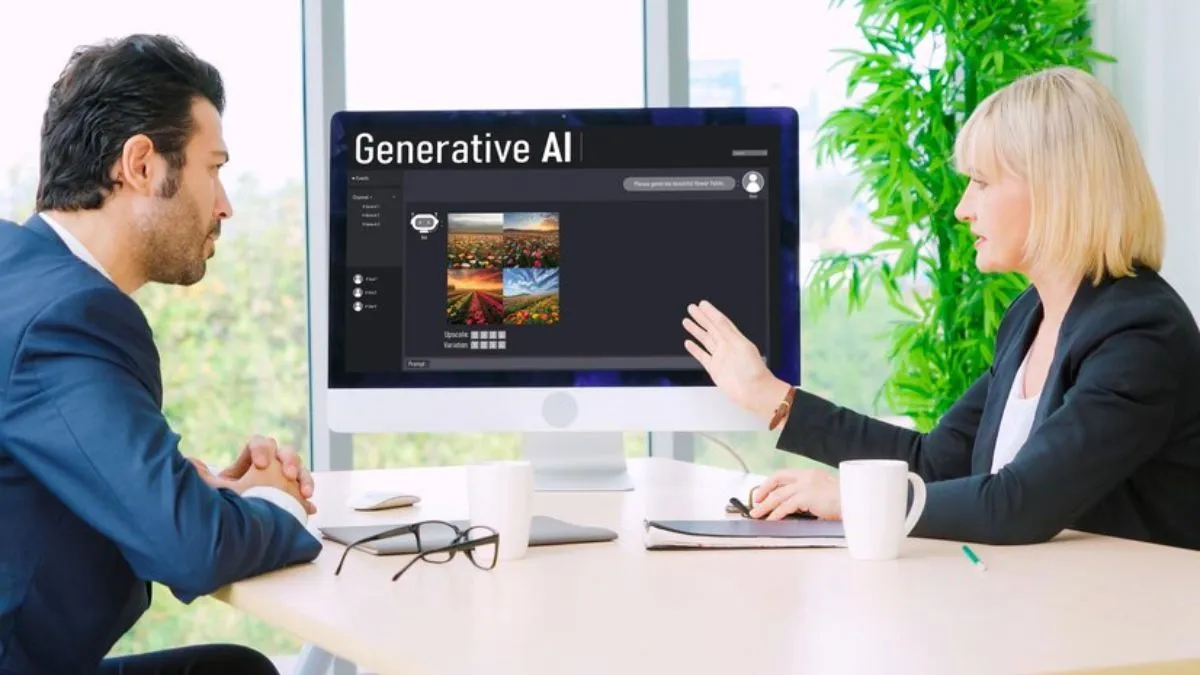
In today’s fast-paced business world, crafting compelling sales pitches is crucial. With attention spans shrinking, it’s essential to engage your audience quickly and effectively. One way to achieve this is by using AI-powered video presentations. These tools can help create dynamic, professional presentations with minimal effort, offering a powerful way to showcase your products or services. In this guide, we’ll walk you through the steps to build AI-powered video presentations that can elevate your sales pitches and captivate potential clients.
Understanding AI-Powered Video Presentation Tools
AI-powered video presentation tools are revolutionizing the way we create and deliver presentations. These platforms use artificial intelligence to automate key tasks such as scriptwriting, video generating, and even the selection of background music or images. By leveraging AI, sales teams can create visually engaging content that enhances their pitches without the need for extensive video generating skills. These tools allow for greater efficiency and creativity, making them ideal for sales professionals who need to create multiple presentations in a short amount of time.
Benefits of AI-Powered Video Presentations for Sales
Incorporating AI into your video presentations offers several benefits. First, AI tools save time by automating repetitive tasks such as creating transitions or syncing voiceovers. Second, they ensure consistency in messaging, helping sales teams present a unified and polished narrative. Lastly, AI-powered presentations are more engaging for the audience, as they often incorporate visually appealing elements that keep viewers’ attention. For sales pitches, these benefits translate into more persuasive and impactful presentations, leading to higher conversion rates.
Choosing the Right AI Video Presentation Tool
To create AI-powered video presentations, you need the right tool. There are many AI-powered platforms available, each offering different features. When selecting a tool, consider the following: ease of use, customization options, and the ability to integrate with your existing software. For sales teams, tools that offer quick generating capabilities and pre-made templates can be invaluable. Also, make sure the tool supports features like voiceover integration, video trimming, and the ability to add real-time data, which can make your sales pitch even more effective.
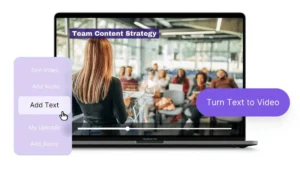
Crafting the Perfect Script for Your Sales Pitch
The script is the foundation of your AI-powered video presentation. Start by outlining your key points and structuring your script to emphasize your product’s benefits and how it solves the customer’s pain points. Since AI tools can automatically generate scripts, ensure that the generated content aligns with your sales goals and messaging. It’s always a good idea to review and personalize the script for a more human touch, ensuring that it resonates with your target audience. A well-crafted script, paired with AI’s generating abilities, will result in a compelling video presentation.
Adding Engaging Visuals with AI
Visuals play a vital role in video presentations. They make your message more memorable and help convey complex information quickly. AI-powered tools, such as an AI presentation maker, can help you select relevant visuals, images, and videos based on your script. Many platforms have access to stock footage libraries or offer suggestions for animations that complement your message. This feature allows you to create visually stunning presentations without having to source or design content manually. The right visuals, combined with AI’s automated features, can help your sales pitch stand out from the competition.
Integrating Voiceovers with AI
A voiceover can add a personal touch to your video presentation, making your pitch more engaging and relatable. Many AI-powered tools offer text-to-speech options in multiple languages, allowing you to create professional voiceovers in minutes. Choose a voice that matches your brand’s tone and the nature of your presentation. If you want a more personalized approach, some tools allow you to upload your own voice recordings and explore how to do AI voice cloning, which can be synced with the visuals and script automatically. This level of customization can make your AI-powered video presentation feel more human and less robotic.
Utilizing AI to Incorporate Real-Time Data
Sales pitches are more effective when they include real-time data. AI-powered tools often allow you to integrate up-to-date charts, graphs, or metrics into your presentations. This can be particularly useful in a sales pitch, where showing real-time performance metrics or industry trends can make a significant impact. By presenting data visually through dynamic charts and graphs, you can make your case more convincingly. Ensure that your AI tool supports real-time data integration, so you can update your sales presentation as new data becomes available.
Personalizing Your Presentation with AI
Personalization is key to a successful sales pitch. AI tools make it easier to tailor your presentations to specific clients or industries. You can create multiple versions of a single presentation, each customized for different target audiences. Whether it’s altering the script slightly to address specific pain points or adding industry-relevant statistics, AI can help you quickly adjust your presentation without starting from scratch. This ensures that each sales pitch feels tailored and relevant, which is crucial for building stronger client relationships.
Enhancing the Presentation with Background Music
Adding background music to your presentation can help set the tone and keep your audience engaged. AI-powered video tools can automatically suggest background music that matches the theme and pace of your presentation. Whether you’re aiming for something upbeat to energize your viewers or a more subtle track to maintain focus, AI tools can help you select and integrate the perfect soundtrack. Music can also guide the flow of the presentation, helping you emphasize key points and create a more immersive experience for your audience.
Testing and Optimizing Your AI-Powered Presentation
Before delivering your sales pitch, it’s essential to test your AI-powered video presentation. Watch it from the perspective of your audience and look for areas where the presentation can be improved. Many AI tools offer feedback options or analytics that can show you how long viewers engage with each section of your presentation. Use this data to optimize your video, ensuring that key points are clear and that the pacing is right. Continuous optimization will help you refine your presentation for maximum impact.
Delivering a Persuasive Sales Pitch with AI-Driven Video
Once your AI-powered video presentation is ready, the next step is delivery. While the video can do much of the heavy lifting, your role in delivering a persuasive pitch is still critical. Practice speaking in sync with the video, adding live commentary where appropriate to further emphasize important points. AI-powered presentations provide you with a solid foundation, but your energy, passion, and knowledge will help close the deal. A well-executed pitch that leverages the power of AI technology can leave a lasting impression on your audience.
Conclusion: The Future of Sales Pitches with AI Video Presentations
AI-powered video presentations represent the future of sales pitches, offering a fast, efficient, and highly engaging way to connect with potential clients. By automating tasks like scriptwriting, visual selection, and voiceover integration, AI tools allow sales professionals to focus on personalizing their message and delivering a compelling pitch. As AI technology continues to evolve, the potential for creating even more immersive and persuasive sales presentations will only grow. Start exploring AI-powered video tools today to stay ahead in the competitive world of sales.

AI
How Businesses Can Use AI Video Editors to Boost Marketing and Ads

Video marketing isn’t just an option anymore—it’s a necessity. With social media platforms prioritizing video content and audiences engaging more with visuals, businesses must step up their game. However, traditional video editing can be expensive, time-consuming, and require professional expertise. This is where an AI video editor steps in, offering a smart, automated approach to creating high-quality videos in minutes.
AI video editors streamline the process, allowing businesses to create professional marketing and advertising content without needing an entire production team. From generating promotional clips to creating AI-powered video presentations and resizing content for multiple platforms, these tools make video marketing accessible to everyone. Even if you don’t have prior editing experience, AI-powered automation ensures that your content looks polished and engaging with minimal effort.
The Business Benefits of AI Video Editing
AI video editing is transforming the way businesses create content, making the process faster, more affordable, and highly efficient. By automating key editing tasks, AI tools allow brands to maintain consistency, optimize engagement, and maximize their return on investment. Here’s how AI video editing benefits businesses:
1. Efficiency & Speed
Time is money, and AI video editors significantly cut down the time needed to produce high-quality videos. Traditional editing can take hours—or even days—while AI tools can generate polished content in minutes. Automated scene transitions, smart trimming, and auto-generated captions remove the need for manual editing, allowing businesses to focus on content creation rather than tedious post-production.
2. Cost Savings
Hiring a professional video editor or subscribing to high-end editing software can be costly. AI video editors provide an affordable alternative, reducing the need for a dedicated team while delivering professional results. Many AI tools also offer free versions with powerful features, making it easier for small businesses and startups to compete with larger brands.
3. Brand Consistency
AI-generated templates ensure brand consistency across all marketing materials. Businesses can maintain uniform styles, fonts, colors, and transitions in their videos, reinforcing their brand identity across multiple platforms. This is especially important for companies that frequently post on social media or run ad campaigns across different channels.
4. Increased Engagement
AI video editors optimize content for maximum engagement by applying smart enhancements like dynamic transitions, auto-subtitles, and background music. Videos created using AI are designed to keep viewers hooked, increasing watch time and boosting conversion rates.
AI Video Editors in Action: Real-World Business Use Cases
AI video editing isn’t just a futuristic concept—it’s actively transforming the way businesses create and distribute video content. From marketing campaigns to customer engagement, here’s how businesses are leveraging AI video editors in practical scenarios:
1. Instant Ad Creation
Businesses can quickly create professional advertisements using AI-generated templates. Instead of starting from scratch, AI tools analyze content needs and generate high-quality promotional videos in minutes.
2. Social Media Optimization
AI video editors can automatically format videos for different platforms, ensuring that content fits Instagram, TikTok, YouTube, and other social media channels without extra effort. For example, using a video resizer ensures that your Instagram content is perfectly optimized.
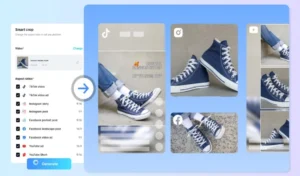
3. Customer Testimonials & Reviews
Video testimonials build trust and credibility. AI-powered tools enhance customer testimonials by improving audio quality, adding captions, and creating smooth transitions, making them more appealing to potential customers.
4. Educational Content & Webinars
AI-generated captions and voiceovers help businesses create professional webinars, training videos, and tutorials with ease. Automated tools ensure clarity and accessibility, making educational content more engaging.
5. Personalized Video Campaigns
AI tools can analyze audience data and generate personalized video campaigns tailored to different customer segments. Businesses can create dynamic, data-driven video ads that resonate with their target audience, improving engagement and conversion rates.
Inside an AI Video Editor: How It Works
AI video editors rely on machine learning and automation to simplify video creation. Here’s a closer look at their core functionalities:
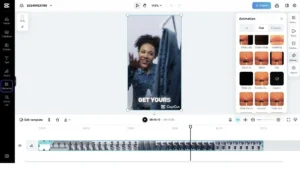
- AI Scene Detection: Automatically detects and trims unnecessary footage, creating seamless transitions for a polished final product.
- Voice & Text AI Integration: Generates automated voiceovers and captions, making videos accessible and engaging.
- Automated Effects & Enhancements: Adds smart filters, animations, and background music with a single click, giving videos a professional touch.
- Smart Recommendations: AI tools analyze video content and suggest improvements, optimizing the final output for maximum impact.
Step-by-Step Guide: How to Use AI Video Editors for Marketing
AI video editors simplify the marketing process by automating key editing tasks, making content creation faster and more effective. Pippit takes this a step further by offering powerful AI-driven tools for seamless editing, branding, and optimization. Here’s how you can use AI video editors to enhance your marketing strategy:
1. Select a Template
Start by uploading your video clips or choosing from AI-generated templates. Pippit analyzes your content and suggests the best structure, ensuring a professional look without the need for extensive editing skills.

2. Customize with AI Tools
Make your video stand out by adjusting branding elements, adding text overlays, and using AI-generated voiceovers. Pippit enhances your content with dynamic transitions, music, and smart effects to boost engagement.

3. Optimize & Export
SEO optimization is key to reaching the right audience. AI-powered tools in Pippit suggest high-ranking video titles, descriptions, and tags. Once finalized, export your video in multiple formats optimized for YouTube, Instagram, and other platforms.

4. Distribute & Analyze Performance
After publishing your video, track its success with AI-driven insights. Pippit provides data on viewer engagement, watch time, and interaction rates, helping you refine your strategy and improve future content.
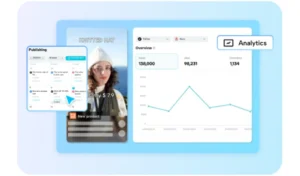
AI Video Editing Tools: Choosing the Right Fit for Your Business
With so many AI video editors available, choosing the right one depends on your business needs. Here’s what to consider:
- Feature Set: Does it include templates, voiceovers, auto-subtitles, and advanced editing tools?
- Ease of Use: Is it beginner-friendly, or does it require technical expertise?
- Cost: Does it offer free features, or is a premium subscription required?
- Platform Compatibility: Can you export videos in multiple formats for different platforms?
Some AI video editors are better suited for quick social media videos, while others offer advanced editing tools for professional content creation. Businesses should experiment with different tools to find the best fit.
The Future of AI Video Editing in Business Marketing
AI video editing is evolving rapidly, and businesses that adopt this technology early will have a competitive edge. Here’s what the future holds:
- Hyper-Personalization: AI tools will create tailored video content for individual viewers based on their interests and behaviors.
- Automated Interactive Videos: AI will enable clickable elements within videos, enhancing user engagement.
- Voice & Language Adaptation: Advanced AI will generate voiceovers in multiple languages, allowing businesses to reach global audiences effortlessly.
- Predictive Analytics for Video Success: AI will analyze data trends and suggest content strategies to maximize engagement.
As AI continues to improve, video marketing will become more accessible, efficient, and powerful, allowing businesses of all sizes to create high-quality content without technical barriers.
Final Thoughts: Making AI Video Editing Work for Your Brand
AI video editors have transformed the way businesses approach video marketing. Whether you’re creating ads, educational content, or social media posts, AI-powered tools make the process faster, more affordable, and highly effective. By leveraging AI, businesses can scale their video marketing strategies, maintain brand consistency, and engage audiences effortlessly. The future of marketing belongs to brands that embrace automation, and AI video editors are the key to staying ahead in an increasingly digital world.
AI
Lillienu: AI-Powered Platform for Smarter Decision Making

Lillienu is the most advanced AI, ML, and cloud camping platform that brings digital structures to optimality. As designed to handle maximum traffic data to analyzing nature, it help businesses to come up with accurate quick decisions. Lillienu meets current trends and increasing demand for automation and intelligent systems targeted at non-car businesses by implementing advanced algorithms and technologies needed for large business organization with large customer base. It is mainly concentrated on deriving value from the software from the users’ perspective as well as improving collaborators’ efficiency while deploying decision making processes and proper functioning. Dealing with the customer or dealing with large shipments of data, it provides solutions that enhance performance, minimize expenses, and increase accuracy of decision-making.
Understanding AI-Powered Decision Making
AI integrated decision making refers to using artificial intelligence to make decisions through analysis, pattern recognition and defining subsequent course of action. This has a positive effect on the speed and accuracy of business decision making processes that enable organizations change strategy with speed in responding to changing market conditions. This is improved on by machine learning, a sub category of artificial intelligence since it allows a system to learn from the data it has been fed, make predictions and improve on its decision making process each time. Lillienu goes a step further by including cloud since the program will have to be scalable and accessible. It further integrates these technologies to enable dynamic and data driven decisions making across industries.
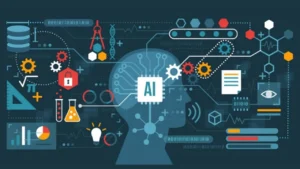
Applications of Lillienu in Various Industries
- Healthcare: Enhances diagnoses and treatment planning with advanced data analysis and AI-driven insights.
- Retail: Optimizes inventory management, demand forecasting, and customer personalization for improved sales strategies.
- Finance: Detects fraud, assesses risks, and enhances financial forecasting with accurate, data-driven tools.
- Manufacturing: Streamlines supply chains, improves production efficiency, and reduces waste through predictive analytics.
- Education: Personalizes e-learning experiences and improves institutional efficiency using AI-powered solutions.
Key Features of Lillienu
Lillienu offers a range of features that redefine digital optimization. Its advanced data processing capabilities allow organizations to handle massive datasets efficiently. Integration with existing systems ensures seamless adoption without disrupting current workflows. Real-time analytics provide insights that drive informed decisions, while automation streamlines processes, reducing manual effort. Additionally, its ability to personalize solutions makes it adaptable to various industries. By enhancing system performance through AI algorithms and leveraging cloud computing for storage and accessibility, it creates a robust platform for businesses. These features collectively make Lillienu an invaluable tool for enhancing decision-making, improving efficiency, and achieving sustainable growth.
How Lillienu Optimizes Digital Systems
Lillienu increases efficiency in the process by elimination of repetitive tasks in various digital systems. Using AI algorithms, the computer evaluates and processes data and immediately shows areas of problem and ways to fix them. Third, the cloud solutions that the platform is integrated with guarantee data storage and retrieval as well as scalability. For instance, a retail company might employ it to identify consumer’s behavior in buying patterns and manage the appropriate stock management, or possibly a health care entity may possibly improve the delivery of care through smart health status tracking. By automating routine processes and delivering insights, it improves overall system performance. It transforms digital operations, empowering organizations to focus on innovation and strategy rather than mundane tasks.
Benefits of Using Lillienu
- Increased Efficiency: Automates tasks and streamlines workflows to boost operational performance.
- Cost Reduction: Minimizes manual intervention and resource wastage, leading to significant cost savings.
- Enhanced Decision-Making: Provides accurate, data-driven insights to support informed business decisions.
- Improved User Experience: Personalizes services and delivers faster solutions for superior customer satisfaction.
- Scalability and Adaptability: Scales seamlessly with organizational growth, addressing evolving operational needs effectively.
Integration and Implementation of Lillienu
Integrating Lillienu into existing systems is seamless due to its compatibility with diverse digital platforms. The implementation process involves assessing organizational needs, customizing solutions, and deploying the platform with minimal disruption. Businesses can integrate Lillienu with CRM, ERP, and other enterprise systems to maximize efficiency. Customization options ensure that the platform aligns with unique business requirements. Once implemented, it starts analyzing workflows, identifying inefficiencies, and delivering actionable insights. Organizations also receive ongoing support for updates and system enhancements. This adaptability and ease of integration make it ideal choice for businesses looking to harness the power of AI, ML, and cloud computing.
Security and Reliability
Security and reliability is important for Lillienu. It also includes advanced encryption protocols in a way that all form of information which is sensitive cannot be accessed by anyone else apart from the user. The platform’s architectural design has also integrated AI to not only recognize but also prevent cyber threats in advance. Other tools regarding where data is backed up and recovered add to the reliability; protecting it from events that may occur. On this basis, it secures and provides relevant data storage based on cloud computing by allowing scalable access to the resources. These measures also help to pay attention to the regulations Regarding data protection and also gain the trust of the users.

Read Also: How to protect user data and user’s data privacy?
Future of AI and ML with Lillienu
Based on the current development and analysis, Lillienu is ready to spearhead the next generation of AI and ML adoption. Upcoming trends reveal enhanced promotion of intelligent technologies in the market. Through growth the company adapts to the development of technologies in the future, a factor making Lillienu relevant in future. The purpose of elaborating such platform has its desire on the automation process, scalability, and personalization, which corresponds to the increasing importance of intelligent systems. Some furtherance can be made on the use of more accurate forecasting or the gadgets, or real-time communication applications.
Conclusion
Lillienu is a relatively unseen advancement in the current age making use of artificial intelligence in decision making and digitization. When applied together as AI, ML, and cloud computing merge, it enables the business to make better decisions quicker and more accurately. It is a high value tool across industries due to it flexibility, productivity and adaptability that fosters innovation and efficiency. Used for improving the overall user experience to managing work processes, it changes the way that organizations prevail in the new world.. As businesses continue to embrace AI-driven solutions, it stands out as a pioneering platform that combines cutting-edge technology with practical applications. Embracing it means investing in the future of smarter, data-driven decision-making.
AI
Parallel Artificial Intelligence: Revolutionizing Speed, Efficiency, and Scalability in AI Systems

Artificial Intelligence is transforming the world. But as AI grows, so does the need for speed. Traditional AI struggles with large-scale computations. Enter Parallel Artificial Intelligence. This game-changer spreads complex tasks across multiple processors, slashing processing time. Think of it like a kitchen. One chef makes a meal slowly. A team? They finish fast. That’s Parallel AI—breaking tasks into smaller chunks, working together. Industries need it. Healthcare, finance, autonomous vehicles—everywhere speed matters. The demand for real-time AI solutions is rising. Parallel AI meets that demand. It’s the future of AI scalability and efficiency. And it’s happening now.
What is Parallel Artificial Intelligence?
Parallel Artificial Intelligence is AI steroids. Rather than processing step for step, it processes several operations at once. It’s a lot of brains working on one problem at a time. The old AI processed sequentially, taking one task at a time. But actual-world AI applications—autonomous cars, big data analysis—require quick responses. Parallel AI chops up tasks and spreads them among several computing units. This accelerates learning, improves efficiency, and enables AI to process gigantic datasets with ease. It’s a business revolutionizer, research booster, and AI engineer facilitator. As more AI is applied, Parallel AI is no longer a want—it’s a need.
The Evolution of Parallel AI
The history of Parallel Artificial Intelligence is intriguing. It began as a mere concept: why not employ multiple processors rather than one? Parallel computing was only a fantasy in the 1950s. Single-core systems were used for early AI models. Slow and inefficient. Then came multi-core processors. GPUs transformed AI training. Today, we have TPUs, cloud computing, and even quantum AI on the horizon. Each advance makes Parallel AI stronger. Firms such as Google and Nvidia are pushing the limits, making AI quicker than ever. The revolution is not yet complete. The next wave? AI supercomputing, where computers think at lightning speed.
How Parallel Computing Works in AI
Parallel computing is similar to teamwork. Rather than have one person do everything, several people do part of it. Parallel Artificial Intelligence is the same. It breaks difficult problems up into parts, which are solved at once. There are two big methods: data parallelism and task parallelism. Data parallelism breaks down large data sets into several processors, ideal for deep learning. Task parallelism distributes different tasks into different processors, ideal for workflow optimization. GPUs, TPUs, and cloud clusters drive these computations, which make AI models smarter, faster. The outcome? AI which learns fast, responds in real-time, and manages enormous workloads with ease.
Benefits of Parallel AI
Speed. Efficiency. Scalability. These are the pillars of Parallel Artificial Intelligence. Traditional AI models take weeks to train. Parallel AI slashes that time. It processes data in real-time, crucial for industries like finance and healthcare. Handling big data? No problem. Parallel AI scales effortlessly, managing massive datasets without bottlenecks. Real-time decision-making becomes seamless. Imagine self-driving cars reacting instantly or fraud detection systems catching threats before they happen. That’s Parallel AI in action. The world demands faster AI. Parallel AI delivers. It’s not just an upgrade—it’s a necessity for modern AI applications.
Applications of Parallel AI in Different Industries
Parallel Artificial Intelligence is everywhere. In healthcare, it analyzes medical images instantly, diagnosing diseases faster. In finance, it powers algorithmic trading, processing thousands of transactions per second. Autonomous vehicles? They rely on Parallel AI for real-time navigation. Even gaming benefits, with AI-driven NPC behavior adapting dynamically. Big data analytics, cybersecurity, robotics—the list goes on. Businesses adopting Parallel AI stay ahead, making smarter, faster decisions. Without it, industries lag. With it, they innovate. Every second counts in AI. Parallel AI ensures industries don’t just keep up—they lead.
Parallel AI in Deep Learning and Neural Networks
Deep learning thrives on Parallel Artificial Intelligence. Why? Because training neural networks is computationally heavy. Traditional AI models take days, sometimes weeks, to train. Parallel AI speeds up this process. It distributes computations across GPUs and TPUs, making learning faster and more efficient. Neural networks, with millions of parameters, require extensive processing power. Parallel AI handles it effortlessly. Cloud computing further boosts performance, allowing models to train on distributed servers worldwide. The result? Smarter AI, faster breakthroughs, and real-time learning. Parallel AI isn’t optional for deep learning—it’s the backbone.

Challenges and Limitations of Parallel AI
Nothing’s perfect. Parallel Artificial Intelligence faces hurdles. Hardware costs? High. Not every business can afford multi-GPU setups. Power consumption? Massive. Energy efficiency is a concern. Programming complexity? It’s tough. Parallelizing AI algorithms requires expertise. Synchronization issues? They happen. When multiple processors work together, timing matters. Latency can disrupt efficiency. Despite challenges, research continues. New frameworks, optimized hardware, and improved algorithms are making Parallel AI more accessible. The benefits far outweigh the drawbacks. But to maximize its potential, businesses must invest wisely, balancing power with cost-effectiveness.
Key Technologies Driving Parallel AI
Parallel Artificial Intelligence wouldn’t exist without cutting-edge tech. GPUs revolutionized AI. TPUs took it further, accelerating deep learning. Cloud computing enables distributed AI models, scaling globally. Edge AI brings Parallel AI to smart devices, reducing reliance on centralized servers. Quantum computing? It’s the next frontier, promising speeds beyond imagination. Companies like Google, Nvidia, and IBM drive these advancements, making AI more powerful. Without these technologies, Parallel AI wouldn’t thrive. As hardware evolves, Parallel AI will reach new heights, making real-time intelligence the norm, not the exception.
Future Trends in Parallel AI
What’s next for Parallel Artificial Intelligence? AI supercomputing. Imagine machines processing trillions of calculations in seconds. Quantum AI will push boundaries, making today’s AI seem slow. Automation will increase, reducing human intervention. Ethical AI will become a focus—fair, transparent, and unbiased. AI’s role in cybersecurity, space exploration, and climate modeling will expand. Governments and businesses will invest more, making Parallel AI mainstream. The AI race is accelerating. Those who adopt Parallel AI early? They’ll shape the future. The next decade will redefine intelligence as we know it.
How to Get Started with Parallel AI Development
Curious about Parallel Artificial Intelligence? Start with the right tools. TensorFlow and PyTorch support parallel processing. OpenMP and MPI optimize AI workflows. Programming languages like Python, CUDA, and Julia are essential. Want hands-on learning? Online courses from Coursera, Udacity, and edX offer deep insights. Experiment with cloud-based GPUs from AWS, Google Cloud, or Azure. Join AI forums, read research papers, stay updated. Parallel AI is complex but rewarding. Dive in, learn, and build the future. The AI revolution isn’t coming. It’s already here.
Conclusion
Parallel Artificial Intelligence isn’t just an innovation—it’s a necessity. AI is growing, and without parallel computing, it slows down. Industries rely on it for real-time insights, automation, and scalability. The future? Faster, smarter, more efficient AI. Companies adopting Parallel AI lead the race. Those who ignore it? They fall behind. As technology advances, Parallel AI will drive new possibilities. It’s shaping the next era of artificial intelligence. Ready or not, the AI revolution is here. The question is—are you part of it?
-

 BIOGRAPHY2 months ago
BIOGRAPHY2 months agoBehind the Scenes with Sandra Orlow: An Exclusive Interview
-

 HOME5 months ago
HOME5 months agoDiscovering Insights: A Deep Dive into the //vital-mag.net blog
-

 HOME8 months ago
HOME8 months agoSifangds in Action: Real-Life Applications and Success Stories
-

 BIOGRAPHY5 months ago
BIOGRAPHY5 months agoThe Woman Behind the Comedian: Meet Andrew Santino Wife




